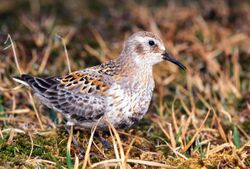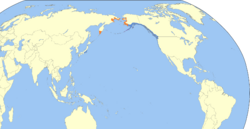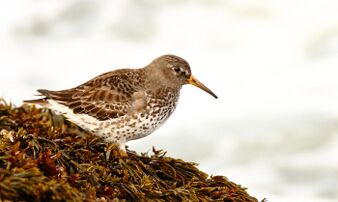Biology:Rock sandpiper
| Rock sandpiper | |
|---|---|

| |
| Scientific classification | |
| Domain: | Eukaryota |
| Kingdom: | Animalia |
| Phylum: | Chordata |
| Class: | Aves |
| Order: | Charadriiformes |
| Family: | Scolopacidae |
| Genus: | Calidris |
| Species: | C. ptilocnemis
|
| Binomial name | |
| Calidris ptilocnemis (Coues, 1873)
| |

| |
| Synonyms | |
|
Erolia ptilocnemis | |
The rock sandpiper (Calidris ptilocnemis) is a small shorebird in the sandpiper family Scolopacidae. This is a hardy sandpiper that breeds in the arctic and subarctic regions of Alaska and the Chukotka and Kamchatka Peninsulas. It is closely related to the purple sandpiper that breeds in arctic regions of northeast Canada and the northwest Palearctic.
Taxonomy
The rock sandpiper was formally described in 1873 by the American ornithologist Elliott Coues and given the binomial name Tringa ptilocnemis.[2] It was formerly placed in the genus Erolia,[3][4] but is now placed with 23 other sandpipers in the genus Calidris that was introduced in 1804 by the German naturalist Blasius Merrem.[5][6] The genus name is from Ancient Greek kalidris or skalidris, a term used by Aristotle for some grey-coloured waterside birds. The specific epithet ptilocnemis combines the Ancient Greek ptilon meaning "feather" with knēmē meaning "leg".[7] Within the genus Calidris the rock sandpiper is closely related to the sanderling (Calidris alba) and dunlin (Calidris alpina) and is sister to the purple sandpiper (Calidris maritima).[8]
Four subspecies are recognised:[6]
- C. p. tschuktschorum, (Portenko, 1937) – breeds on the Chukchi Peninsula and in western Alaska
- C. p. ptilocnemis, (Coues, 1873) – breeds on the Pribilof Islands and on Hall and St. Matthew Islands
- C. p. couesi, (Ridgeway, 1880) – breeds on the Aleutian Islands and on the Alaskan Peninsula
- C. p. quarta, (Hartert, 1920) – breeds on the south of the Kamchatka Peninsula and in the Kuril and Commander Islands
Description
Adults have short yellow legs and a medium thin dark bill. The body is dark on top with a slight purplish gloss and mainly white underneath. The breast is smeared with grey and the rump is black. The Pribilof Islands subspecies of this bird shows a bold black belly patch.
Distribution and habitat
Birds migrate south to rocky ice-free Pacific coasts in winter. The subspecies leap frog each other for winter, with more northerly breeders passing south of more southerly breeders. It can form rather large wintering flocks.
Rock Sandpipers which spend the non-breeding season in the Pacific Basin, Alaska, have to endure harsh conditions where they rely on high prey quality, especially of their primary prey - the bivalve Macoma balthica.[9]
Behaviour and ecology
Breeding
Their breeding habitat is the northern tundra on Arctic Pacific coast of Alaska and the Aleutian and Pribilof Islands. The birds also breed in Kamchatka and the Kuril Islands. The breeding pair is usually monogamous, with pair bonds usually lasting several years. They nest on the ground either elevated on rocks or in lower damp location. The male makes several scrapes; the female chooses one and lays 4 eggs. Both male and female take the responsibility for incubation.
Diet
These birds forage on rocky coasts. They mainly eat insects, mollusks, marine worms, also some plant material. It often feeds up to its breast in water, and often swims. It roosts on rocks near its feeding grounds just above the high tide spray.
References
| Wikimedia Commons has media related to Calidris ptilocnemis. |
- ↑ BirdLife International (2018). "Calidris ptilocnemis". IUCN Red List of Threatened Species 2018: e.T22693424A131929912. doi:10.2305/IUCN.UK.2018-2.RLTS.T22693424A131929912.en. https://www.iucnredlist.org/species/22693424/131929912. Retrieved 12 November 2021.
- ↑ Coues, Elliot (1875). A Report Upon the Condition of Affairs in the Territory of Alaska. Washington: U.S. Government Printing Office. p. 182, Footnote. https://www.biodiversitylibrary.org/page/4429337.
- ↑ Peters, James Lee, ed (1934). Check-List of Birds of the World. 2. Cambridge, Massachusetts: Harvard University Press. p. 285. https://www.biodiversitylibrary.org/page/14483098.
- ↑ Committee on Classification and Nomenclature (1973). "Thirty-Second Supplement to the American Ornithologists' Union Check-List of North American Birds". Auk 90 (2): 411–419 [415]. https://sora.unm.edu/node/22371.
- ↑ Merrem, Blasius (8 June 1804). "Naturgeschichte" (in German). Allgemeine Literatur-Zeitung 168: Col. 542. https://digipress.digitale-sammlungen.de/view/bsb10502034_00451_u001/1. Published anonymously.
- ↑ 6.0 6.1 Gill, Frank; Donsker, David; Rasmussen, Pamela, eds (July 2021). "Sandpipers, snipes, coursers". IOC World Bird List Version 11.2. International Ornithologists' Union. https://www.worldbirdnames.org/bow/sandpipers/.
- ↑ Jobling, James A (2010). The Helm Dictionary of Scientific Bird Names. London: Christopher Helm. pp. 84, 322. ISBN 978-1-4081-2501-4. https://archive.org/details/Helm_Dictionary_of_Scientific_Bird_Names_by_James_A._Jobling.
- ↑ Gibson, Rosemary; Baker, Allan (2012). "Multiple gene sequences resolve phylogenetic relationships in the shorebird suborder Scolopaci (Aves: Charadriiformes)". Molecular Phylogenetics and Evolution 64 (1): 66–72. doi:10.1016/j.ympev.2012.03.008. PMID 22491071.
- ↑ Ruthrauff, D. R.; Dekinga, A.; Gill Jr, R. E.; Piersma, T. (2018). "Energetic solutions of Rock Sandpipers to harsh winter conditions rely on prey quality". Ibis 160 (2): 397–412. doi:10.1111/ibi.12534. http://www.vliz.be/imisdocs/publications/00/311900.pdf.
- "National Geographic" Field Guide to the Birds of North America ISBN:0-7922-6877-6
- Handbook of the Birds of the World Vol 3, Josep del Hoyo editor, ISBN:84-87334-10-5
- "National Audubon Society" The Sibley Guide to Birds, by David Allen Sibley, ISBN:0-679-45122-6
Wikidata ☰ Q737788 entry
 |





